Sony VAIO SE: An IPS Laptop for Under a Grand
by Jarred Walton on April 3, 2012 5:40 PM ESTThe Sony VAIO SE LCD: IPS++, Gamut--
We’ve saved the best for last. Really, this is the major selling point for me, and in fact I’m more than willing to overlook other concerns just for the display on the VAIO SE. Yes, there are other laptops out there with IPS displays, but the professional grade workstations with such panels can easily set you back several grand, and the next closest competitor is Lenovo’s X220. The X220 is clearly targeting a different market (primarily business users), as there’s no optical drive and no discrete GPU, plus it runs at 1366x768 and will still cost $1250 with the premium panel (IPS) upgrade. HP’s Envy 15 with the 1080p Radiance display is another laptop with an IPS panel (reportedly the same panel used in the VAIO SE, only with a glossy sheet of glass placed in front of it), and it also starts at $1250 once you make the LCD upgrade. In other words, if you want an IPS display on a mainstream laptop, there aren’t many viable alternatives right now.
So just how good is the IPS display? If you’re hoping for something that can rival a nice desktop (e.g. non-TN) display, prepare to be disappointed, but compared to pretty much any TN panel laptop it’s a hands down winner. Viewing angles are good, so you can finally look at the display from above or below without getting massive color shifting and/or loss of contrast. Contrast and brightness are also good. The weakest area is arguably the color gamut and color reproduction, but while a 70% or even 95% NTSC color gamut would be nice, given the balancing act between price, panel type, and color gamut I think Sony made the right call here.
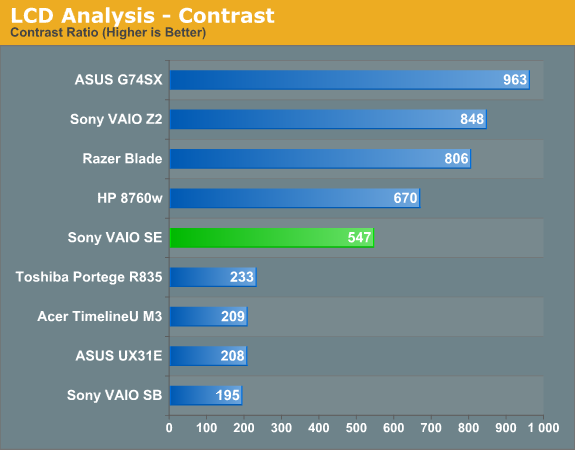
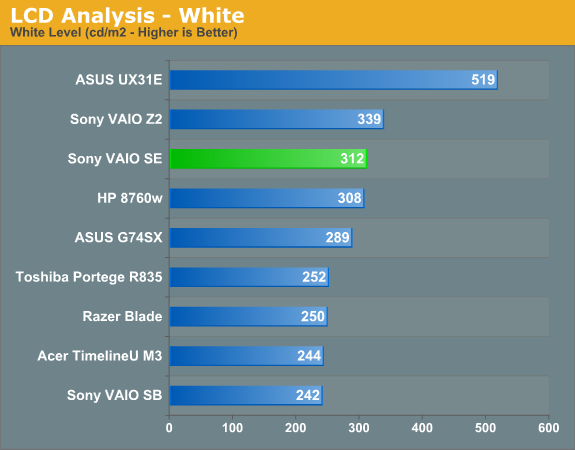

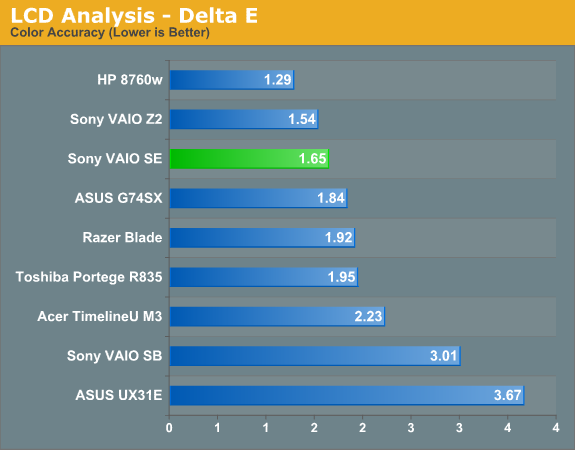
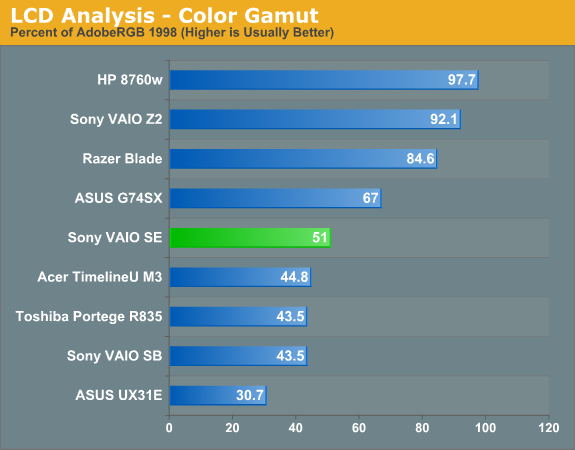
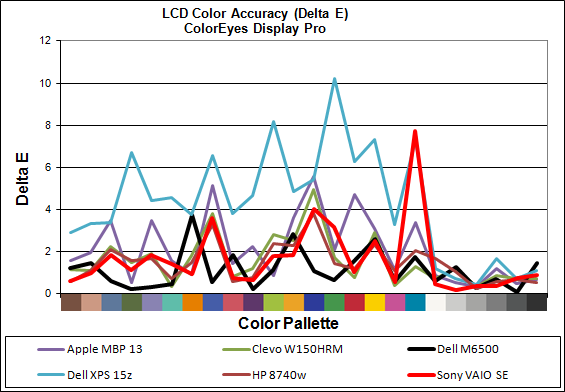
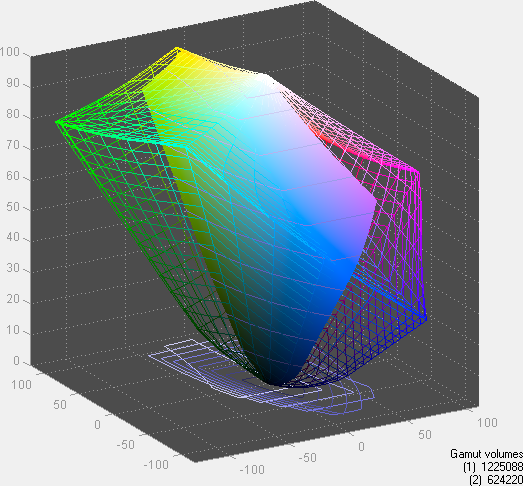
I’m a sucker for a good display—I use a 30” IPS display for my desktop, after all. The VAIO SE isn’t going to rival a 30” desktop display, but at least it has a good resolution and viewing angles, good contrast, and colors that at least match or exceed what you’ll get from 99% of laptops. Oh, and did I mention the LCD also has a matte (anti-glare) coating? Look at the viewing angles and compare them to other laptops (or watch a video like this one—sorry if you can’t understand German, but all you really need to do is watch) and you can see exactly why IPS is superior to TN. Asking for more at this point—especially with a starting price of under $1000—is probably being greedy, but seriously: this is what all laptops should be shipping as a baseline in 2012!
We’ve had decent quality TN panels for at least six years—I know the first high-end laptop I reviewed had a 1920x1200 LCD with good contrast way back in 2006, for cryin’ out loud! We started writing about (mostly complaining about) laptop LCDs in 2007, and roughly five years later what do we have to show for it? Most laptops still ship low contrast, low resolution displays, and the only thing that has universally improved is maximum brightness—and that's mostly thanks to the use of LED backlighting and often at the cost of contrast. It’s great to see that Sony understands the importance of a good laptop LCD, though obviously they have plenty of other laptops that still use “typical junk” LCDs as well. If you want to send the industry a message about the importance of LCD quality on a laptop, buying laptops like the VAIO SE is one of the best ways to make your feelings known.
What About the Colors?
With all the good aspects of the display, it’s important to realize that it’s not perfect. Much ado has been made about the HP Radiance display in the latest Envy 15, specifically that it has an orange/blue skew on red/violet colors. The VAIO SE panel appears to be the same IPS panel, and as you’d expect there’s also some color quality inaccuracies. I’ve taken a couple comparative photos to show you exactly what’s wrong with the color red, with an (old!) Dell 3007WFP (sRGB gamut) display and an HP LP3065 (95% NTSC gamut) showing the same image. I also took a photo of an ASUS K53E in front of the HP to illustrate what you typically see with a lower quality LCD. And speaking of lower quality LCDs, there’s a final image comparing black levels of the VAIO SE to the black levels of the Dell Vostro V131 (both are matte panels), which should help you understand just how bad black levels are on “typical” LCDs.
You can see in the gallery that the VAIO SE reds are clearly shifted more towards orange than the 3007WFP or LP3065. To quote my (nine year old) daughter’s analysis of the three displays: “[The Dell] picture looks sort of orange. [The Sony laptop] looks…even more orange? I dunno, it’s a weird shade of orange. And [the HP] looks red.” At the same time, the ASUS K53E is more pinkish than red and the lack of contrast is noticeable even in a picture of a picture. My daughter called the ASUS a “lighter red.” So yes, even a nine year old can readily see the color differences between the various displays. What it comes down to is this: what do you value most in a display?
A TN panel can give you a decent image when you’re looking straight on, but when viewed from above or below TN panels are notoriously bad. Even the best TN panels—e.g. the AUO B156HW01 v4 used in laptops like the Lenovo W520 and Clevo W150HRQ—are still going to offer a less than stellar experience with off-angle viewing, despite having a wide color gamut. As you can see in the above gallery, the VAIO SE panel (61% sRGB gamut) doesn’t reproduce perfect colors. It’s not terrible, but if you’re an image or video professional and you want to have accurate colors, you’ll need something better than this.
Look at the results from the Dell M6500 display and the HP EliteBook and you can see whay professional displays deliver. For less demanding users, your eyes will mostly adapt to what you see on the screen, so while red might look orange, orange will look like something else and it all (mostly) works out. I can immediately notice the lack in contrast on a laptop without running any specialized tests; for color accuracy, though, it’s something I generally notice only when there’s a reference point nearby.
TL;DR: There’s a reason Dell and HP charge so much for their professional IPS displays on their Precision and EliteBook workstations. As nice as it is to have a $1000 laptop with a decent IPS display, you won’t get the same quality LCD as you would on something like the HP DreamColor. Or in other words: you still get what you pay for.






















59 Comments
View All Comments
peterfares - Tuesday, April 3, 2012 - link
1 4GB stick of RAM costs $20 or less. Just order it without any RAM stick and put the 4GB module in, leaving you with 2x4GB=8GB. 2GB soldered on would have been horrible. I'm already sick of 8GB and want 16GB in my laptop. I will when I get a sandy or ivy bridge laptop. My arrandale only supports 8GB.piroroadkill - Tuesday, April 3, 2012 - link
A perfectly serviceable specification and a great display, for a reasonable enough price.Everyone else needs to pay attention..
bunnyfubbles - Tuesday, April 3, 2012 - link
the screen, relative light weight (you'd be hard pressed to find any other 15+" lappy @ 5.4lbs let alone 4.4), and price really were what sold it for meI was going to go with the 13.3" S series for its portability, and while the 13.3" S series 1600x900 screen was definitely a cut above all other PC laptops that are stuck with 1366x768, the 1080p IPS of the SE really was that much more gorgeous when comparing them side by side in store.
The HDD is a disappointment, however I just upgraded my desktop from a 128GB Crucial M4 to a pair of Samsung 830s, so I was able to plug that M4 into the laptop, as well as replace the 2GB module with a 4GB (was less than $20) for 8GB total. Those two simply hardware upgrades along with a reformat with only the essential software and drivers (all of which can be found pretty easily and conveniently from Sony's support site) lead to a very awesome overall computing experience.
The last upgrade I did was grabbed an external USB DAC. The Speakers on this laptop are extremely anemic, and the onboard sound leaves much to be desired. I have a Creative X-Fi GO! (was less than $30) for when gaming and chatting (has both plugs for headset and mic, laptop itself has only one jack so you can't have both headset and mic, and thus would have to rely on the built in mic on the laptop which is passable but not ideal) and my trusty FiiO E7 when just watching movies or listening to music
The 128GB SSD might not seem like much, but its certainly enough for the OS and apps, and no laptop will be able to satiate my gaming like my desktop, so very few games get installed to it anyway. Anything else (mostly large media files such as music and movies) can be handled via portable USB HDDs and flash thumbdrives, of which I converted the 640GB HDD to a portable drive with a portable 2.5" USB3.0 enclosure.
jigglywiggly - Tuesday, April 3, 2012 - link
I'd take the tn panel 95% ntsc color gamut (The clevo one you were talking about) I have one in my np8130 and it is absolutely amazing. Contrast and brightness is most important thing imo, then viewing angles.piroroadkill - Wednesday, April 4, 2012 - link
I disagree. You're not going to be using a laptop for serious colour sensitive work, but you might have a laptop out to watch a video with a few friends sat around it.charleski - Wednesday, April 4, 2012 - link
On TN panels the gamma changes (usually dramatically) with even a slight movement off-axis. They're completely unsuitable for colour-sensitive work unless you're going to lock your head at the optimum position.There certainly are people who need a decent portable screen for reviewing images, but the available options are very limited.
Stacey Melissa - Tuesday, April 3, 2012 - link
I'm not quite as worried about the hinge, but after three months with my base SE, I agree with the rest of the review, for the most part. I immediately swapped the HDD for a 128GB Crucial M4, and did a clean Win7 install, so performance is pretty good. I only get about 4 to 4.5 hours runtime, but I'm running the screen at fairly high brightness (82%) and turned off a couple obscure power-saving tricks. I'm very picky about noise. Luckily, fan noise is very low for my typical use, which involves browsing, Visual Studio, and video playback. I usually use a Targus wedge laptop cooler, which I don't plug in. Clicks are noisy. The trackpad is placed too far to the right, and I really miss two-finger scrolling. The keyboard is excellent, except for the spacebar, which often doesn't register left-side presses. It could use dedicated volume buttons. I like the manual graphics switching, except that it takes several seconds.Bugs: Scrolling usually quits working after waking from hibernation. To fix, open the mouse control panel, and click OK. The BT hardware sometimes quits working upon resume, even after the driver update that supposedly fixes it. When running on battery, the DVD drive switches on and off regularly and often, which causes the standard hardware attachment/detachment sound notification.
The screen is easily the best I've used on a laptop. It also bests my old Dell 2405 desktop S-IPS in brightness, contrast, and of course sharpness, but not quite in gamut or accuracy.
adece - Tuesday, April 3, 2012 - link
...is actually appealing! What do you knowMrMaestro - Tuesday, April 3, 2012 - link
I bet Dustin wouldn't have minded getting his hands on this laptop to review, how did AnandTech decide who had dibs? Coin toss? Rock-paper-scissors? Fight to the death?JarredWalton - Tuesday, April 3, 2012 - link
Dustin got the Z2, I got the SE... wasn't sure which would be better, but ultimately the Z2 is too costly for what you get and the keyboard doesn't appeal as much.